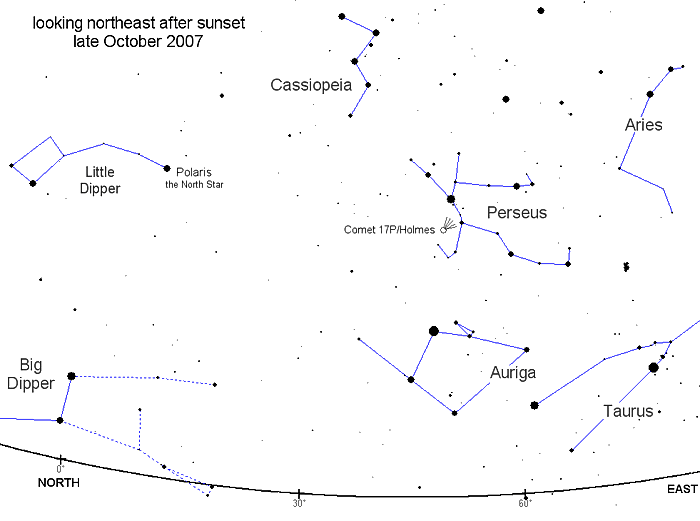O até aqui discreto cometa 17P/Holmes, descoberto em 1892 por Edwin Holmes, surpreendeu na 4ªfeira a comunidade astronómica ao aumentar subitamente de brilho em mais de um milhão de vezes, passando de magnitude 17 para 2.8 em poucas horas. É agora observável mesmo a olho nu na constelação Perseu, assemelhando-se a uma pequena e brilhante estrela amarela.


Incredible comet eruption: from under 17th to 3rd magnitude in hours!
A most amazing eruption is occuring on comet 17P/Holmes which was at 17 mag. at best but on October 24 suddenly began to brighten like crazy: Now (afternoon UTC) it has already reached 3rd magnitude and is easily visible to the naked eye, as reports from Japan indicate: "Perseus does not look 'Perseus' familiar to us due to the bright stellar object now." The comet looks like a bright, yellow star, and only magnification reveals a fuzzy coma around the dusty core. Holmes was discovered in 1892 thanks to a similar outburst, and hope is that the further development will be similar now: the coma should expand over time but stay bright for a week or more. "Following the initial stages of the [1892] outburst, the comet's total magnitude faded only very slowly and it remained visible to the unaided eye for about 3 weeks," advises comet guru John Bortle: "During this interval the coma expanded dramatically (as might be expected), reaching 20'-30' in size before its outer regions began to drop below the sky background." Moreover, there was a second outburst "of almost equal amplitude to the first one, about 75 days following its 1892 November brightening. Thus, I would urge everyone to watch very carefully for a possible repeat of this secondary event about the turn of the year."
http://www.astro.uni-bonn.de/~dfischer/mirror/306.html










 .Mas tambem há muitas luzes no local onde moro...
.Mas tambem há muitas luzes no local onde moro...





